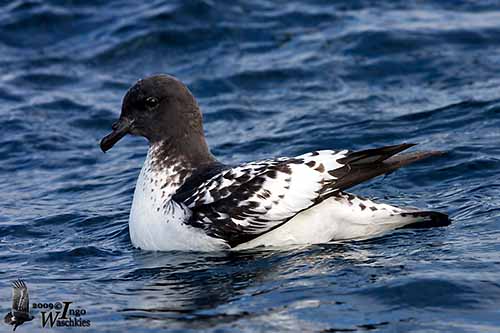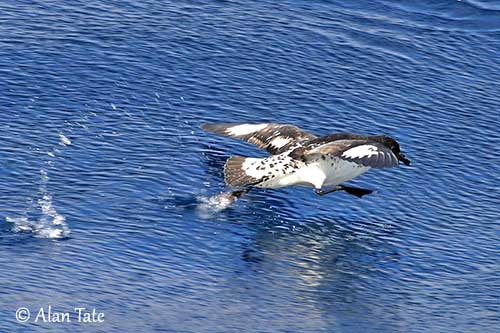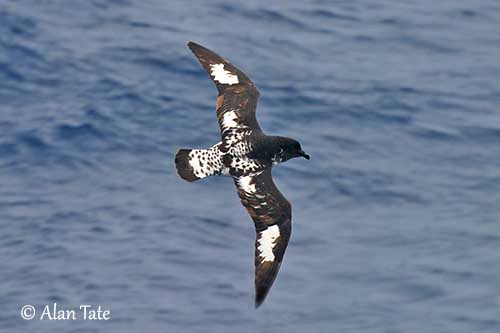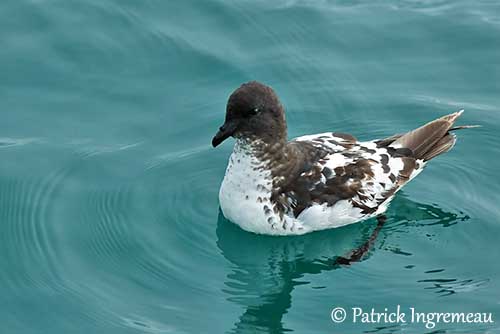
Fr: Damier du Cap
Ang: Cape Petrel – Cape Pigeon – Pintado Petrel
All: Kapsturmvogel
Esp: Petrel Damero
Ita: Procellaria del Capo
Nd: Kaapse Stormvogel
Sd: Brokpetrell
Photographers:
Roger Ahlman
Pbase Galleries Peru and Ecuador
Ken Havard
My Bird Gallery & Flickr gallery 1 & Flickr gallery 2
Patrick Ingremeau
TAMANDUA
Tom Merigan
Tom Merigan’s Photo Galleries
Otto Plantema
Trips around the world
Simon Tan
PBase Bird galleries
Alan & Ann Tate
AA Bird Photography
Ingo Waschkies
My bird pictures on Pbase
Text by Nicole Bouglouan
Sources:
HANDBOOK OF THE BIRDS OF THE WORLD vol 1 by Josep del Hoyo-Andrew Elliot-Jordi Sargatal - Lynx Edicions - ISBN: 8487334105
A Complete Guide to Antarctic Wildlife by Hadoram Shirihai and Illustrated by Brett Jarrett - Edited by Guy M. Kirwan - ALUL.A Press Oy, Finland - ISBN 9519894705
BirdLife International (BirdLife International)
Wikipedia, the free encyclopaedia
Australian Antarctic Division: Leading Australia's Antarctic Program
Ocean Wanderers "Ride the Wave"
Cape Petrel
Daption capensis
Procellariiformes Order – Procellariidae Family
INTRODUCTION:
The Cape Petrel is the only member of the genus Daption, because this species is distinct enough to be placed in a separate monotypic genus. Two subspecies are recognized.
Along with the two members of genus Fulmarus, the Northern Fulmar and the Southern Fulmar, the Cape Petrel is more pelagic than other species and disperses widely over oceanic waters.
This species is very gregarious. It forms large feeding flocks at sea, and breeds colonially. Flocks of hundreds follow the fishing vessels.
This species is also known as the “Cape Pigeon” in reference to its dove-like feeding behaviour. Another name, the “Pintado Petrel” comes from its black-and-white pattern on upperparts that appear to be painted. The generic name “Daption” is an anagram of “pintado”.

DESCRIPTION OF THE BIRD:
Biometrics:
Length: 38-40 cm
Wingspan: 80-90 cm
Weight: 450-480 g
The adult is a medium-sized petrel with rounded head. It has highly distinctive black-and-white checkered pattern on upperparts and upperwings.
Underparts and underwings are white. Both leading and trailing edges are black, like the terminal tail band.
Head, nape and hindneck are black, forming a dark hood extending slightly to the upper mantle. Chin and throat are paler, sooty-brown or even white.
The eyes are dark brown to blackish. Bill, legs and webbed feet are black.
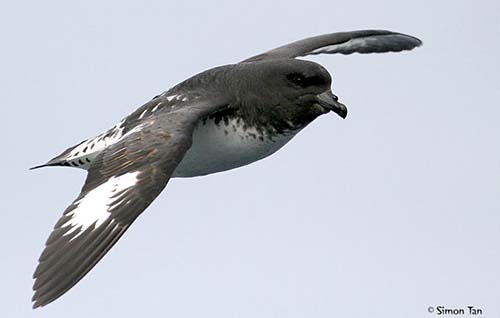
Both adults are similar in plumage, but the female has smaller bill, tarsus, wing length and weight.
The juvenile resembles adult, but the black feathers are washed grey and the feathers show narrow, paler fringes on upper mantle and inner upperwing-coverts.
SUBSPECIES AND RANGE:
The Cape Petrel has two recognized subspecies.
D.c. capense (described above) occurs in Antarctica and subantarctic islands from South Georgia E to Heard Island.
D.c. australe is found in temperate to Antarctic waters, between Australasia and Antarctica. It breeds on islands in New Zealand area.
This race is slightly smaller and the upperparts show more black areas on upperwing and back. However, in worn plumage, the bird shows more white areas.
On the underparts, we can see some blackish spots on undertail-coverts and underwing. The black terminal tail band is broader.
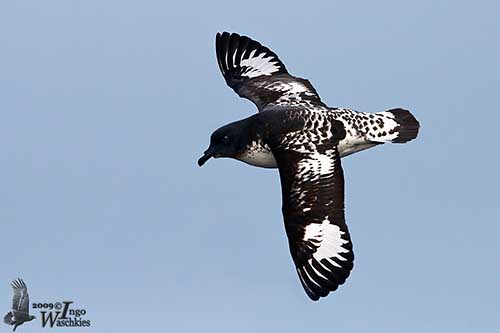
HABITAT:
The Cape Petrel nests on cliffs and rocky slopes in the open, but also on rocky ground within a kilometre from the sea. They breed on islands around the coasts of Antarctica and on subantarctic islands. During the breeding season, it forages mainly close to the colonies. But during winter, it is marine and pelagic, following the cold currents. It usually occurs in cold waters beyond the continental shelf. It avoids the pack-ice but can be seen foraging near icebergs.
CALLS AND SONGS: SOUNDS BY XENO-CANTO
Like numerous seabirds, the Cape Petrel is usually silent away from the colonies. However, the feeding flocks are noisy as the birds compete over food while giving an aggressive, sharp chattering or purring “courrrrr”. Cackling sounds such as “cac-cac, cac-cac” are also produced.
Greeting displays with mutual head swaying are accompanied by similar sounds.
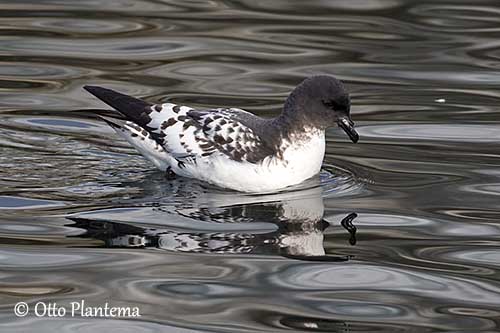
BEHAVIOUR IN THE WILD:
The Cape Petrel feeds mainly on squid, krill of genus Euphausia, medusae and fish, with in addition carrion, offal and galley refuse from fishing boats.
It feeds primarily by surface-seizing, but it can use other techniques such as pattering and hydroplaning.
It picks food in dove-like manner, always very active and busy. It picks ahead and to the sides while sitting high on the water. It also feeds on the wing and performs “dipping” and sometimes dives for catching a prey.
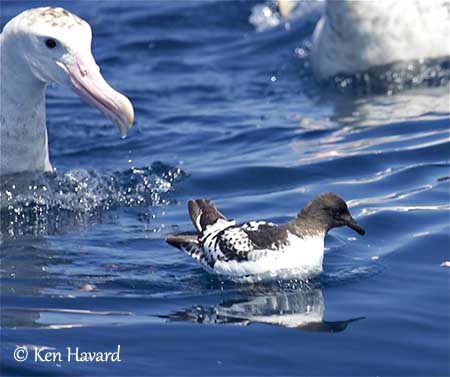
The Cape Petrel forms large flocks while following fishing vessels, sometimes with other seabirds, and in association with large marine mammals that lead the preys towards the surface.
It also feeds at carcasses and may use its sense of smell to locate food.
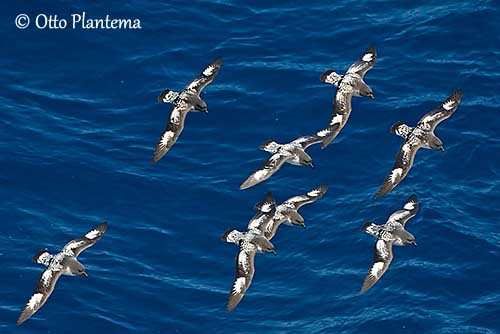
The Cape Petrel is gregarious at sea, but it can be solitary too. It breeds in loose colonies. Mates are monogamous with long-term pair-bonds. They perform elaborate courtship displays. Calling is used to maintain and strengthen the pair bonds.
Both mates perform “head-weaving” at each other, nibbling, cackling and mutual preening. Displays are also used in territorial defence.
The Cape Petrel is absent from Antarctica between April and August, whereas the birds of subantarctic areas could be fairly sedentary. They may follow the major cold currents into more temperate regions, and can be seen off Galapagos Islands at the equator, and mainly at fishing sites. This species is pelagic and disperses widely over oceanic waters.
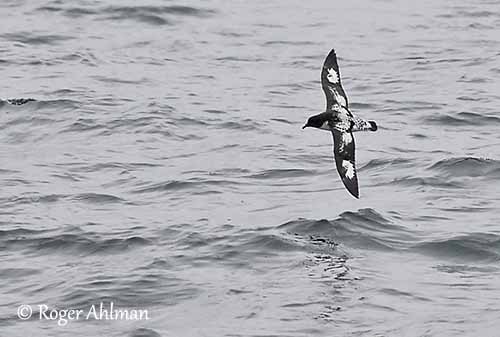
The flight is performed with more wing flapping and shorter glides than in fulmars. The Cape Petrel is a good flier and flies very fast, and sometimes low over water.
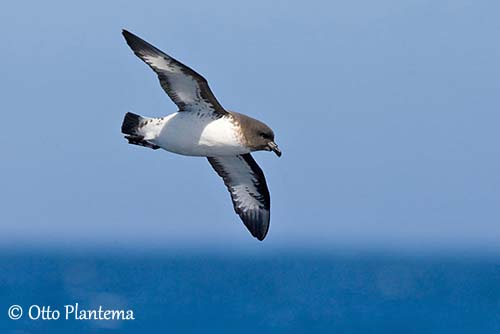
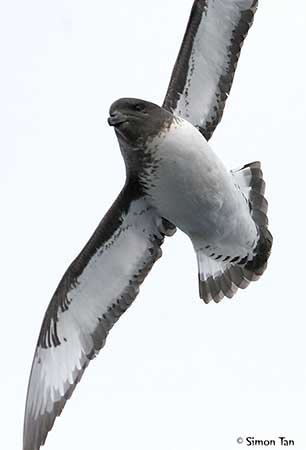
REPRODUCTION OF THIS SPECIES:
The breeding season occurs in November/December. They return to the colonies in September/October, and the female performs a pre-laying feeding trip of 2-3 weeks.
The Cape Petrel forms loose colonies of variable size (up to thousands with other seabirds), whereas it can be solitary like on Crozet Islands.
The colony is established on rocky ground or gravel and high cliffs with ledges. The nest is a scrape of stones and gravel, or placed in shallow rocky crevices, rocky ledges or among boulders.
PROTECTION / THREATS / STATUS:
Most of the breeding sites are free from mammalian predators in New Zealand, but those of Kerguelen, Auckland and Cochons islands are affected by rat and cat predation. Some inhospitable sites are a good natural protection against intruders and predators.
However, the Cape Petrel is widespread and abundant in its range, and the global population is estimated at 2,000,000 individuals.
Currently, the Cape Petrel is evaluated as Least Concern.
